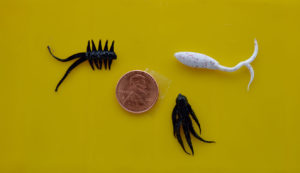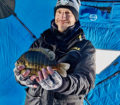By Bob Jensen
Fishing the Midwest Fishing Team

(photo by Bob Jensen) Different shape baits have different wiggles. The upper left plastic bait is a Jamei XL, the upper right is a Mino XL, and the lower right is a Maki Fathead. Each will be productive in different situations.
Plastic tails that we put on the back of our jigs have proven themselves to be fish-catchers. However, until the past few years, there has been the belief that plastics are most productive in warm water fishing situations. In cold water, slow presentations are usually more productive, and again until the past few years, it’s been hard to get plastic baits to wiggle with a slow presentation. If the jig wasn’t moving quickly, the plastic didn’t wiggle very much.
With the introduction of different manufacturing processes, the companies who make plastic baits have learned how to make them wiggle at slow speeds. Because of this, more anglers are using plastic tails on their jigs to catch walleyes in cold water in the fall and panfish through the ice in the winter. Rage Swimmers have become the go-to plastic for walleyes on rivers year ‘round, and a variety of plastics have replaced waxworms and spikes for panfish while ice fishing.
John Crane is an outstanding multi-specie and all-season angler and has been in on this plastic bait phenomena for a good number of years. In a recent conversation, he offered some ideas about why an angler would want to use plastic when ice fishing. Following are some of his thoughts on that.
One of the appeals of plastic is the cold-hand factor. An angler can usually catch several fish on a plastic bait, but often will need to rebait after every fish when using live bait. To put live bait on, anglers need to take their gloves off. When you take your gloves off in the winter, your hands get cold. Your hands don’t get as cold when plastic is used.
Also, because we’re not rebaiting after every fish, we can get the bait back down the hole and to the fish quicker. That can be a big deal. Often, a pod of fish will go through but they’re moving. The faster you can get your bait back down there, the more of the fish you’ll catch from that pod.
Live bait pretty much wiggles the same way. Plastic baits come in different shapes and wiggle in different ways. On some days the fish will prefer a particular wiggle. By experimenting with different wiggles, an angler can figure which wiggle the fish want on that day.
Perhaps the most important factor is the texture of the bait. Some baits like Maki baits are hand-poured. Hand poured baits are much softer. You don’t have to provide much action to the bait to make it wiggle. That gets the fish’s attention.
When the fish inhales the soft bait, it hangs on longer, giving an angler more time to set the hook. Hard plastic baits don’t wiggle as much, so they don’t attract fish as well. And when a fish does inhale the hard bait, it will quickly reject it. It’s hard to believe how quickly a fish can hit and spit a hard plastic bait.
So, since the soft bait is softer, does that make it less durable? J.C. says they’re a little less durable, but a single bait will still catch a lot of fish. J.C. says that he can catch a lot of fish on a single bait, and if he goes through a pack of Maki baits in a day, that has been a very good day.
Like many anglers, J.C. likes to employ a jig head of one color with a body of another color. His favorites are a pink Drop Jig with a white Maki body or a Drop Jig with some orange and a chartreuse body.
Some ice anglers still feel better if they have some live bait in their pocket, but more and more of the most successful fish-catchers rely on plastic to put fish on the ice. If you haven’t already, give plastic a chance. You will more than likely become one of those anglers who realize that plastic will usually result in better fish catches.
















